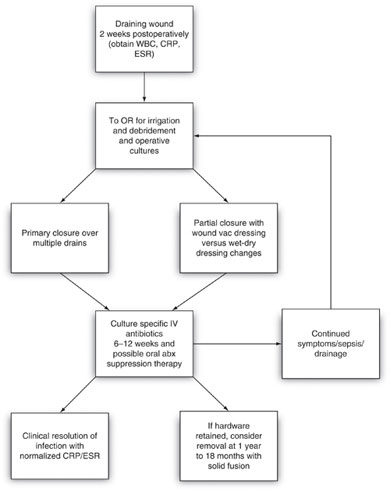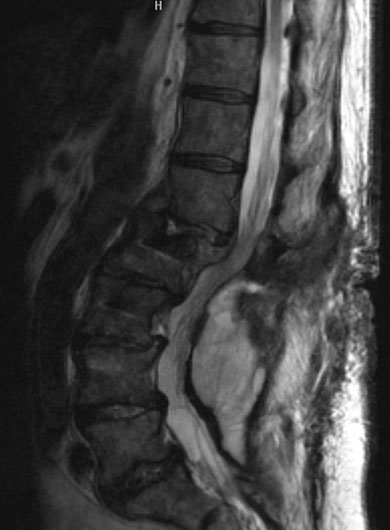Draining Wound After Lumbar Laminectomy Fusion
Patients presenting with a draining wound more than 2 weeks after surgery should be treated for a probable infection. Several studies have shown that prolonged wound drainage is associated with an increased risk of infection.1 We treat these patients with an operative debridement with the assumption of a deep infection (Figure 19-1). The wound should be opened and all superficial sutures removed because these are sources of retained bacteria. Superficial tissue and fluid samples should be sent for aerobic, anaerobic, and fungal cultures as well as for pathology. The superficial wound should be debrided of any nonviable tissue, followed by pulsatile-lavage irrigation of the superficial wound. Only once the superficial wound is cleaned should the deep fascia be opened. Irrigation of the deep wound should also be performed using pulse lavage, taking care to retain the previous bone graft as long as it does not appear to be grossly infected and/or loose (Figure 19-2).

Figure 19-1. Flow diagram of treatment of surgical infection.

Figure 19-2. MRI study of deep wound infection. T2 weighted image shows collection of fluid deep in the fascia during the acute postoperative period.
If instrumentation is present, we retain the hardware in the setting of an acute infection because it provides stability for the fusion. The fascia is then closed over a deep suction drain, preferably with an absorbable monofilament suture. The decision to close the skin primarily, allow healing by secondary intention, or use a vacuum-assisted wound-closure device depends on the severity of the infection. Patients with relatively mild drainage and without gross purulence may be closed primarily with the placement of multiple drains (we prefer Jackson-Pratt drains). These drains should be left in place until drainage is minimal. Those patients with gross purulence should undergo multiple irrigation and debridement procedures every 48 to 72 hours until definitive closure. If the wound continues to appear purulent after multiple irrigation and debridement procedures, or primary closure is difficult, vacuum-assisted closure (VAC) should be considered.
VAC may be helpful in patients with an impaired wound, including the malnourished and elderly. The VAC sponge is placed on top of the fascia after a partial wound closure. VAC can be used with good results even in more complex wounds where exposed hardware is present. The advantages of the VAC device over the traditional wet-to-dry dressing changes are faster wound healing and the convenience of less frequent dressing changes.
In all cases, we place patients on broad-spectrum intravenous antibiotics while cultures are pending. An infectious disease consultation should be obtained. A peripherally inserted central venous catheter should be inserted in anticipation of 6 to 12 weeks of culture-specific antibiotics. Serial measurements of WBC count, erythrocyte sedimentation rate (ESR), and C-reactive protein (CRP) should be performed to monitor the response of the infection to the antibiotic regimen. We tend to rely upon the CRP as a measure of response to treatment because it has been clinically correlated.2 The ESR can sometimes remain elevated even in the face of clinical improvement.2 Recurrent drainage or signs of systemic illness should prompt the surgeon to consider repeated operative debridement. If tissue coverage of the existing instrumentation is not possible, plastic surgical consultation for flap coverage should be considered.
References
1. Beiner JM, Grauer J, Kwon BK, et al. Postoperative wound infections of the spine. Neurosurg Focus. 2003;15:E14.
2. Khan MH, Smith PN, Rao N, et al. Serum C-reactive protein levels correlate with clinical response in patients treated with antibiotics for wound infections after spinal surgery. Spine. 2006;6:311-315.
